Samsung Galaxy S8: Rising from the Note 7 Ashes
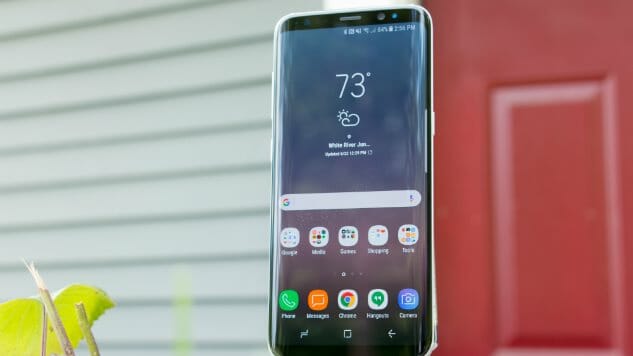
The Note 7 disaster would have destroyed most companies. A controversy that large, handled that poorly, should have crippled Samsung, but the Korean electronics giant is too big to fail or, at least, too big to fail yet.
Still, the company needed a win in the worst way in 2017. It needed to release a phone that was beautiful enough, powerful enough and safe enough to help distance the memories of exploding phablets and botched recalls. It did. There has never been as good a response to disaster in the tech world as the Galaxy S8.
Samsung’s latest flagship may be the most beautiful phone ever made, with a glorious edge-to-edge display that feels like the future, pushing the entire idea of the smartphone forward for the first time in years, but it doesn’t stop there. The experience of using the S8 is solid all around, proving there’s more to the device than it’s sleek exterior, and that Samsung is ready to be back on top.
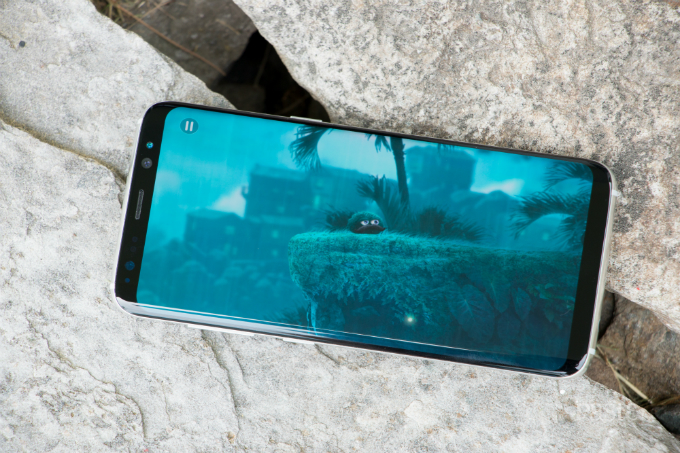 If you’ve yet to see the stunning new hardware of the Galaxy S8, you must be roommates with Patrick Star. From leaks, to the eventual reveal, the edge-to-edge display has dominated the news cycle surrounding Samsung’s latest flagship. After years of underwhelming changes on the hardware front for smartphones, the S8, and other screen-focused products like the LG G6, feel like the future. Like the S7 and Note 7 before it, the S8 is expertly built, refined and polished into one of the best builds you’ll find on any device.
If you’ve yet to see the stunning new hardware of the Galaxy S8, you must be roommates with Patrick Star. From leaks, to the eventual reveal, the edge-to-edge display has dominated the news cycle surrounding Samsung’s latest flagship. After years of underwhelming changes on the hardware front for smartphones, the S8, and other screen-focused products like the LG G6, feel like the future. Like the S7 and Note 7 before it, the S8 is expertly built, refined and polished into one of the best builds you’ll find on any device.
The display is of course the centerpiece, and it is something to behold. The 5.8-inch screen is unlike any other large display you’ve likely come across thanks to the lack of significant bezels and super tall, 18.5:9, aspect ratio. Coupled with the elegant curves on the front and rear of the device, and the S8 fits into even small hands nicely. As with any phone in 2017, it still takes a bit of hand gymnastics to reach the top corners, particularly because it’s so tall, but if you’ve longed for a large screen without the immense footprint of a phablet, the S8 is a perfect compromise. Having only used the standard edition, I can’t vouch for how well the taller, thinner, design works with the S8 Plus, which comes with a 6.2-inch screen, but I imagine it’s similar to its smaller brother.
The 5.8-inch panel is bright, vibrant and sharp. Because of the unusual aspect ratio, not all apps take advantage of the extra space, though you can customize which use the full display in the settings. When the real estate available is properly put to use, the results are spectacular. It’s the closest any product has come to feeling like pure display. Watching YouTube videos, which does crop the footage slightly, and playing games is stunning and immersive. There is no better multimedia experience on a smartphone, period.
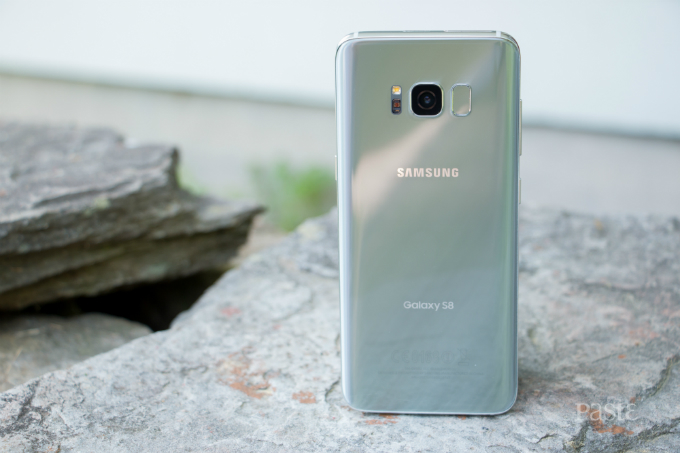 Outside the display and construction, the hardware does show a few rough edges. The most noted is the awkward positioning of the fingerprint scanner. Placing it next to the camera was a stupid choice. It didn’t annoy me as much as anticipated, but I did resort to using either the face, retina or pattern unlock options because the fingerprint scanner was slow and inaccurate much of the time, and I imagine its placement affected the performance a great deal. The company would be wise to listen to the slew of complaints and relocate the reader for the S9.
Outside the display and construction, the hardware does show a few rough edges. The most noted is the awkward positioning of the fingerprint scanner. Placing it next to the camera was a stupid choice. It didn’t annoy me as much as anticipated, but I did resort to using either the face, retina or pattern unlock options because the fingerprint scanner was slow and inaccurate much of the time, and I imagine its placement affected the performance a great deal. The company would be wise to listen to the slew of complaints and relocate the reader for the S9.
Then there’s the issue of the speaker. A single, down-firing speaker is what’s offered on the S8 and it doesn’t get very loud, offers tinny sound that gets distorted at higher levels and is easily covered when in landscape, which most people will employ for games or videos. Samsung is not solely at fault for the dearth of high-quality speakers on flagship smartphones, but the blemish is more apparent on a device like this, that is so focused on offering a great multimedia experience. It’s embarrassing.
 As has been the case for years, though the materials are premium, and feel phenomenal in the hand, they are also slippery and get grimy fast. Most users will throw a case on immediately, or at least a skin, but for anyone who may want to rock the S8 naked, make sure you have a microfiber cloth handy at all times. During longer gaming sessions, there is no denying the S8 gets disgusting, but the tradeoff is a handsome body that looks wonderful and draws the eye (when clean).
As has been the case for years, though the materials are premium, and feel phenomenal in the hand, they are also slippery and get grimy fast. Most users will throw a case on immediately, or at least a skin, but for anyone who may want to rock the S8 naked, make sure you have a microfiber cloth handy at all times. During longer gaming sessions, there is no denying the S8 gets disgusting, but the tradeoff is a handsome body that looks wonderful and draws the eye (when clean).
 Finally, the button arrangement. Samsung took a big swing by giving its new virtual assistant, Bixby, a dedicated hardware button, which is fine if the company believes in the technology and wants to push it aggressively. But why, why, did they have to put in on the same side as the volume rocker? The intelligent move would have been to pair the power button and volume rocker together, leaving Bixby alone on the left side. There were countless times I tried to to change the volume only to have my finger slip and activate Bixby, which in turn made my heart drop.
Finally, the button arrangement. Samsung took a big swing by giving its new virtual assistant, Bixby, a dedicated hardware button, which is fine if the company believes in the technology and wants to push it aggressively. But why, why, did they have to put in on the same side as the volume rocker? The intelligent move would have been to pair the power button and volume rocker together, leaving Bixby alone on the left side. There were countless times I tried to to change the volume only to have my finger slip and activate Bixby, which in turn made my heart drop.
Outside those issues, though, there aren’t many nits to be picked in terms of hardware and design for the S8. It’s the best phone Samsung has made in that regard, with only the fallen Note 7 coming close. It’s premium, beautifully made, stunning to look at and comes with the features you’d expect from a top-tier flagship, like an SD card slot and water resistance. Unless the Pixel 2, new iPhone or the company’s own Note 8 have anything to say about it later this year, the S8 will be the most beautiful phone released in 2017.
-

-

-

-

-

-

-

-

-

-

-

-

-

-

-

-

-

-

-

-

-

-

-

-

-

-

-

-

-

-

-

-

-

-

-

-

-

-

-

-

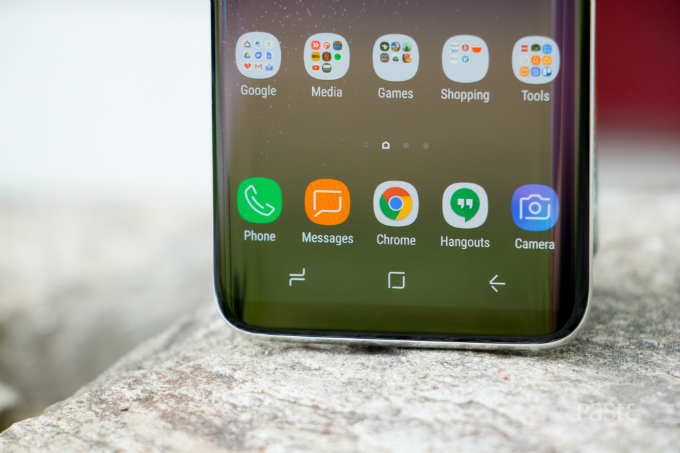 Hardware hasn’t been the issue, however, since the materials and construction were upped for good with the S6. The issue has always been software, and many of the same problems that plagued the Galaxy line for years show up here as well. Samsung has never been willing to rely on the work of others, but instead tried to prove it can build software just as well as Google. In reality, though, that has always been a fantasy held only within the company. From the outside, most of the tech world (myself included) will attest that Google is the unrivaled king of software in the Android ecosystem, and there’s little to be done to change that at this point. But that doesn’t stop Samsung from trying.
Hardware hasn’t been the issue, however, since the materials and construction were upped for good with the S6. The issue has always been software, and many of the same problems that plagued the Galaxy line for years show up here as well. Samsung has never been willing to rely on the work of others, but instead tried to prove it can build software just as well as Google. In reality, though, that has always been a fantasy held only within the company. From the outside, most of the tech world (myself included) will attest that Google is the unrivaled king of software in the Android ecosystem, and there’s little to be done to change that at this point. But that doesn’t stop Samsung from trying.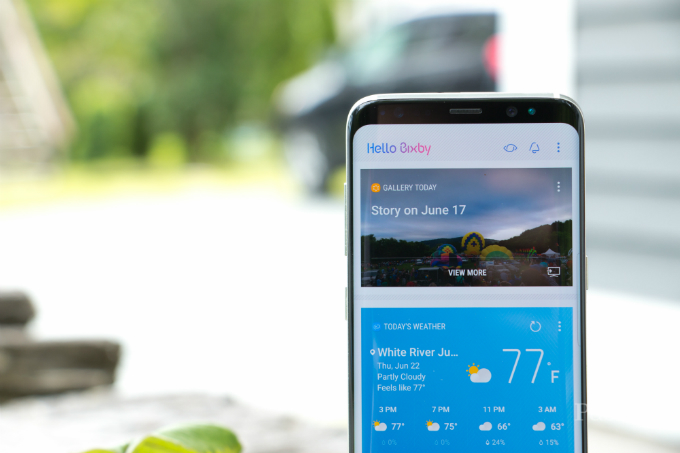 The big software feature this year, though, has to do with Google’s other big push in 2016, the Google Assistant. That virtual helper is on the S8 (accessed by long pressing the home button), but Samsung is joining the fray with its own take on Siri, Alexa and Google Assistant, Bixby. Like a lot of the company’s attempts at duplicating software ideas, Bixby is confounding and minimally useful. It can’t take on the Google Assistant yet because voice commands aren’t supported, though coming very soon, leaving Bixby as little more than a Google Now ripoff. Swipe to the left from the home screen and you’ll find a stream of news, weather, your health stats, social media feeds and various other pieces of information Bixby thinks may be of use. It’s meant to learn more about you as you use it, but it provides such little utility that I had a hard time justifying paying it a visit more than once a day.
The big software feature this year, though, has to do with Google’s other big push in 2016, the Google Assistant. That virtual helper is on the S8 (accessed by long pressing the home button), but Samsung is joining the fray with its own take on Siri, Alexa and Google Assistant, Bixby. Like a lot of the company’s attempts at duplicating software ideas, Bixby is confounding and minimally useful. It can’t take on the Google Assistant yet because voice commands aren’t supported, though coming very soon, leaving Bixby as little more than a Google Now ripoff. Swipe to the left from the home screen and you’ll find a stream of news, weather, your health stats, social media feeds and various other pieces of information Bixby thinks may be of use. It’s meant to learn more about you as you use it, but it provides such little utility that I had a hard time justifying paying it a visit more than once a day. The other primary use for Bixby shows up in the camera app and is dubbed Bixby Vision. When Bixby Vision is enabled, users can point the camera at an object and the virtual assistant will detect what the item is and offer various actions, like the ability to see similar images online or shopping options. In my experience, it works just okay. I pointed the camera at a book I’m reading and it gave me shopping options for the exact title, but I also pointed it at a can of Founder’s All Day IPA and Bixby was only able to recognize the object as a canned beverage of some sort, not specifically a can of beer.
The other primary use for Bixby shows up in the camera app and is dubbed Bixby Vision. When Bixby Vision is enabled, users can point the camera at an object and the virtual assistant will detect what the item is and offer various actions, like the ability to see similar images online or shopping options. In my experience, it works just okay. I pointed the camera at a book I’m reading and it gave me shopping options for the exact title, but I also pointed it at a can of Founder’s All Day IPA and Bixby was only able to recognize the object as a canned beverage of some sort, not specifically a can of beer.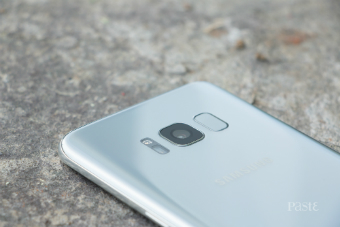 Internally, the S8 has all the specs you’d hope to see from a flagship of its premium quality. A Snapdragon 835 powers the device, alongside 4GB of RAM, an Adreno 540 GPU and 64GB of memory. The top-of-the-line specs are good enough to have the S8 perform admirably through even the heaviest use. I did see occasional hiccups, some of them resulting in cripplingly slow performance, but the issue was usually cleared up in a few minutes or with a quick reboot. As I said above, though, the problem is not how it performs out of the box, but how it ages. I can’t attest to how well the S8 will age, but I wouldn’t be surprised if it is a very different device a year from now.
Internally, the S8 has all the specs you’d hope to see from a flagship of its premium quality. A Snapdragon 835 powers the device, alongside 4GB of RAM, an Adreno 540 GPU and 64GB of memory. The top-of-the-line specs are good enough to have the S8 perform admirably through even the heaviest use. I did see occasional hiccups, some of them resulting in cripplingly slow performance, but the issue was usually cleared up in a few minutes or with a quick reboot. As I said above, though, the problem is not how it performs out of the box, but how it ages. I can’t attest to how well the S8 will age, but I wouldn’t be surprised if it is a very different device a year from now.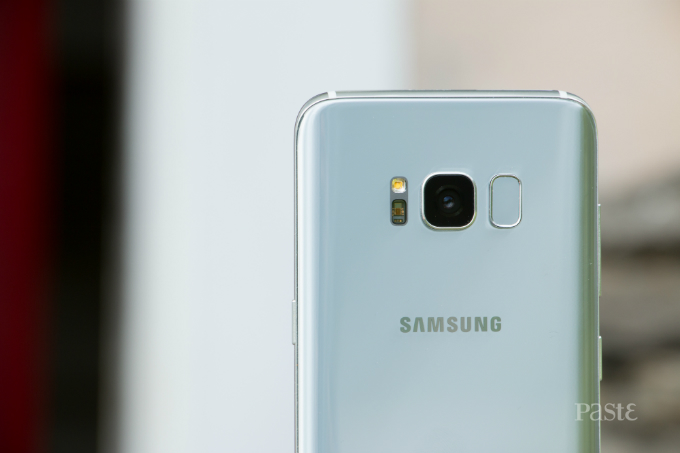 Another area Samsung showed uncharacteristic reservation is the camera. Instead of hopping on the dual-camera trend, the company stood pat with its system from last year. There were improvements made on the software side and in image processing, but the raw specs are the same. On the back is a 12 megapixel, f/1.7 shooter with phase detection autofocus, optical image stabilization and LED flash. The front is an 8 megapixel, f/1.7 selfie camera, which is an improvement in hardware over last year. The good news is that, despite the lack of an upgrade, the rear camera was one of the best on the market last year and the quality in 2017 is still near the top.
Another area Samsung showed uncharacteristic reservation is the camera. Instead of hopping on the dual-camera trend, the company stood pat with its system from last year. There were improvements made on the software side and in image processing, but the raw specs are the same. On the back is a 12 megapixel, f/1.7 shooter with phase detection autofocus, optical image stabilization and LED flash. The front is an 8 megapixel, f/1.7 selfie camera, which is an improvement in hardware over last year. The good news is that, despite the lack of an upgrade, the rear camera was one of the best on the market last year and the quality in 2017 is still near the top. In good lighting, the S8 camera performs wonderfully. Detail is phenomenal, colors are vibrant and dynamic range is stellar. Any smartphone camera worth a damn should be able to offer good results when the sun is shining, and the S8 does. When lighting becomes limited, the camera still does a nice job but has been usurped in that regard by the Pixel. Samsung’s shooter tends to artificially lighten the scene too much, whereas the Pixel offers a more accurate representation. Still, the results are quite good, though noise is noticeable and detail takes a considerable hit. Compared to other cameras, however, the S8 performs about the same as the best of the best in low light given there is only so much that can be done with the limitations of the form factor.
In good lighting, the S8 camera performs wonderfully. Detail is phenomenal, colors are vibrant and dynamic range is stellar. Any smartphone camera worth a damn should be able to offer good results when the sun is shining, and the S8 does. When lighting becomes limited, the camera still does a nice job but has been usurped in that regard by the Pixel. Samsung’s shooter tends to artificially lighten the scene too much, whereas the Pixel offers a more accurate representation. Still, the results are quite good, though noise is noticeable and detail takes a considerable hit. Compared to other cameras, however, the S8 performs about the same as the best of the best in low light given there is only so much that can be done with the limitations of the form factor. Samsung needed a big win after the Note 7 disaster, and the Galaxy S8 is it. While not a pitch perfect phone, the latest flagship from the Korean giant is the best it’s ever made, and an easy frontrunner for phone of the year. It not only pushes the company’s portfolio forward, but the entire industry with its elegant and futuristic design that prioritizes the display without bloating the size.
Samsung needed a big win after the Note 7 disaster, and the Galaxy S8 is it. While not a pitch perfect phone, the latest flagship from the Korean giant is the best it’s ever made, and an easy frontrunner for phone of the year. It not only pushes the company’s portfolio forward, but the entire industry with its elegant and futuristic design that prioritizes the display without bloating the size.






































